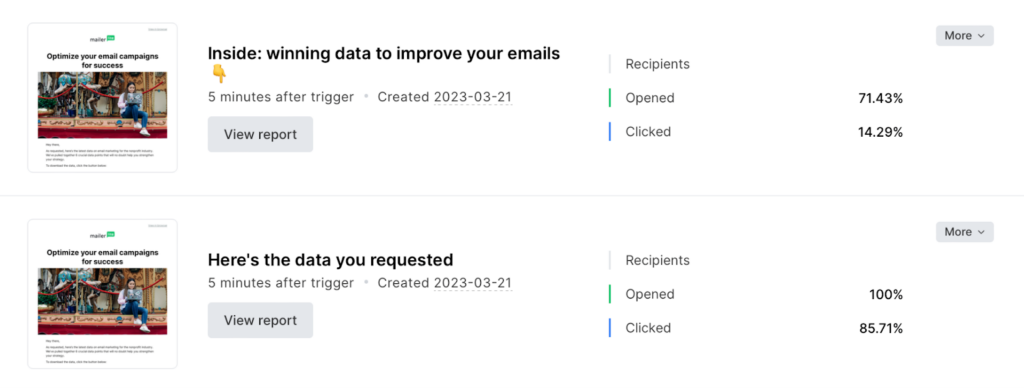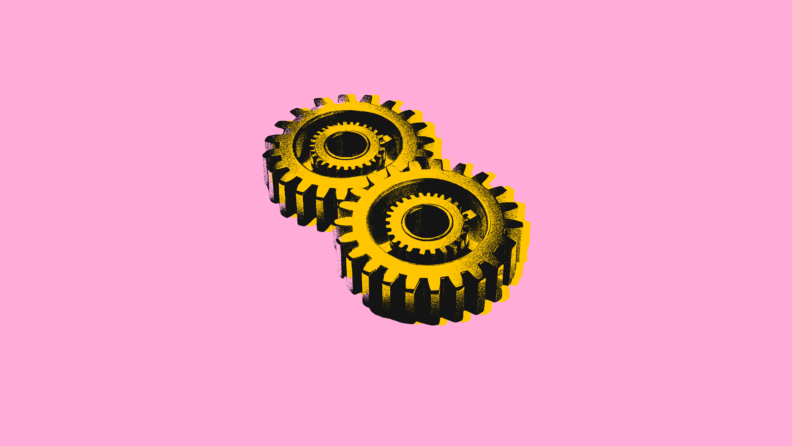There are dozens of marketing automation examples out there for anyone looking to kickstart a marketing automation program. But that also means you run the risk of picking a use case that doesn't do enough to justify your investment.
If you're looking to ensure your CFO isn't breathing down your neck by the time renewal season comes around, here are 10 effective marketing automation examples that guarantee an ROI on your marketing automation software.
But first, why marketing automation.
Why Use Marketing Automation
Well, because marketing automation exemplifies what it means to do more with less. Implementing a marketing automation program almost guarantees an increase in productivity, saves time, and more. Let's explore this in detail.
Saves Time and Improves Productivity
According to Ascend2, around 35% of marketers report that their customer journeys are “mostly automated” or “fully automated”. By automating repetitive tasks such as email marketing, social media posting, and lead nurturing, marketers can focus on more strategic activities.
As the saying goes, time is precious, and you want your marketers to be using their time on the big things that matter. Additionally, automation makes sure no opportunity is missed due to human error or oversight.
Using marketing workflow software drastically reduces the time spent on routine and tedious tasks, allowing your team to work smarter not harder.
Boosts Return on Investment (ROI)
Spending the money to implement marketing automation guarantees a great return on investment. The tools help you track and analyze campaign performance, enabling you to make more informed decisions on where to put your money.
According to Statistica, 97% of visitors to your website will leave without making a purchase. Marketing automation uses behavior triggers, push notifications, and email blasts to stay at your potential customer’s front of mind. This has the potential to increase your revenue significantly.
Using marketing automation not only streamlines work flows, but also keeps marketing efforts profitable.
Improves the Customer Experience
43% of marketers say that the biggest benefit that comes from marketing automation is the improvement of customer experience (Ascend2). A positive customer experience is the end goal for all sales and marketing efforts.
Customer expectations are higher than ever, and delivering a personalized experience is key to building brand loyalty and driving sales. With marketing automation, you’ll create thoughtful, personalized, and timely touch points to bring in higher engagement rates and customer satisfaction.
By improving your customer experience, you’ll see long-term relationships and an increase in customer lifetime value.
10 Marketing Automation Examples that Show How to Use It
So, you’ve decided on using marketing automation and you’ve chosen your marketing automation software. Now, let’s take a look at how at 10 examples of marketing automation software being put to use.
1. Customer Onboarding
Automated customer onboarding processes can include welcome emails, product tutorials, and support resources. Automating the onboarding process gives a positive first impression and encourages long-term customer loyalty.
You also:
- Ensure new customers feel welcomed and informed.
- Reduce the workload on customer support teams.
- Increase customer satisfaction and retention.
Spotify shows how a simple email can make a positive first impression with subscribers. They greet the subscriber and remind them what they signed up for!

2. Lead Scoring
You can use automation to score leads based on their interactions with your brand, such as website visits, email opens, and content downloads. By scoring leads, your sales teams can focus on the most promising prospects and:
- Increase sales efficiency.
- Improve conversion rates.
- Align the marketing and sales teams.
Engagebay is a great marketing automation example of the different ways leads can be segmented through scoring. You can send a product email to the person who “visited a page”, continue to send emails to the person who “opened an email”, and follow up with more info about the event for the person who “registered for a webinar” (the highest scoring lead).

3. Cold Outreach
One great use case of marketing automation is to automate the process of reaching out to customers who have never interacted with your brand before. This expands your customer base and generates new leads by introducing your brand to new prospects. It also enables you:
- Increase the efficiency of your outreach efforts.
- Allow for personalized messaging at scale.
- Track the effectiveness of outreach campaigns.
In the example below, the sales team have automated the first name placement to allow them send a lot more emails than they would if they had to manually type in the recipient’s name.

4. A/B Testing Email Marketing Campaigns
Use automation to conduct A/B tests on different email marketing strategies to determine the most effective approach. Which gets the most opens, which gets the most click throughs? You’re also be able to:
- Identify what resonates with your audience.
- Increase engagement rates.
- Provide data-driven insights for future campaigns.
Here are two examples of A/B testing in an email campaign:
Emoji or no emoji 👇🏼

Longer vs. shorter subject lines 👇🏼

5. Reduce Customer Wait Times
No one wants to sit around and wait for a customer support person for hours on end. Automated systems can help you to quickly address common customer inquiries and issues. We live in a world where we expect prompt responses, so reducing wait times:
- Enhances customer service efficiency.
- Increases customer satisfaction.
- Reduces the burden on support teams
Delta implemented a Virtual Assistant that has reduced call center volumes by 20%! By pointing customers to resources first, they can problem solve on their own before needing to talk to a representative.

6. Customer NPS Surveys
You want to have continuous feedback on your customer experience. A marketing automation solution can automate the distribution and analysis of your Net Promoter Score (NPS) surveys (these surveys provide valuable feedback on customer satisfaction and loyalty). Additionally, NPS scores help you to:
- Gather customer feedback efficiently.
- Identify areas for improvement.
- Track changes in customer sentiment over time.
State Farm sends surveys to their customers asking about their experience working with an agent. They use a star system and make it easy for people to give feedback.

7. Customer Re-engagement Campaigns
Sometimes you’ll fall off someone’s top of mind. Automation helps you to reach out to inactive customers and rekindle their interest in your brand. This is also a great way to maintain a relationship with customers who may have lost interest while:
- Increasing customer retention.
- Boosting sales from re-engaged customers.
- Enhancing customer lifetime value.
Harvest uses a quick email to highlights what customers love about the service. This email aims to get unengaged customers to reactivate their trial.

8. Lead Nurturing
With marketing automation workflows, you can program targeted content and follow-ups to keep in consistent communication with your leads. You also end up:
- Increasing lead conversion rates.
- Enhancing the efficiency of the sales funnel.
- Building stronger relationships with prospects.
9. Email Drip Campaigns
An email drip sounds like what it is, an automated sequences of emails that drips out to leads and customers over a set period of time. It should keep your audience engaged with regular and relevant content. Additionally, lead drip campaigns help to:
- Increase engagement and open rates.
- Build trust and rapport with your audience.
- Drive conversions over time.
Vsco sends this email out to individuals who started to fill out the form for Vsco PRO but didn’t finish the process. It talks about product details, offers them a free trial, and highlights their community platform.

10. Cross-selling and Up-selling
Use automation to suggest additional products or services to existing customers. By encouraging existing customers to make additional purposes, you increase your customer’s lifetime value and:
- Increase average order value.
- Enhance customer satisfaction by providing relevant suggestions.
- Boost overall sales.
Hitting you with another Spotify example. This email is sent to Spotify Free users to encourage them to upgrade to Spotify Premium (and includes a free trial).

4 Tips For Building a Successful Marketing Automation Workflow
Building an industry standard marketing automation workflow requires careful planning. Here are four tips to help you get started.
1. Know Your Target Audience
Plain and simple, you must understand your audience's needs, preferences, and behaviors. This ensures that your automation efforts are tailored to the right people, which will lead to better engagement. Spending time to understand your target audience also ensures you:
- Increasesthe relevance of your marketing messages.
- Improve customer satisfaction.
- Improve overall campaign performance.
2. Align on Your Marketing Automation Goals
Set 100% clear and measurable goals for your marketing automation efforts. By having this direction and focus, your automation efforts are often aligned with your business objectives. You also end up:
- Improving the effectiveness of your campaigns.
- Enabling better tracking and measurement of success.
- Making sure all team members are on the same page.
3. Integrate with a CRM
Ensure you connect your marketing automation tools with your Customer Relationship Management (CRM) system. This guarantees seamless data flow and a unified view of customer interactions. You also benefit from:
- Enhanced accuracy of your customer data.
- Improved efficiency of your marketing and sales efforts.
- Personalized and targeted marketing.
4. Monitor and Optimize Results
Regularly track and analyze the performance of your automation workflows to look for continuous improvements. This helps your automation efforts reach desired results. You also:
- Identify areas for improvement.
- Enhance campaign performance.
- Stay aligned with your goals.
Join For More Marketing Automation Tips and Tricks
Marketing automation is more than a trend, it’s an approach that can redefine how you engage with your audience and streamline your business operations.
You’ll be able to automate repetitive tasks, freeing up your team’s time for strategic activities. You’ll optimize marketing efforts, leading to higher returns, get more personalized, timely interactions.
Where will you start evaluating your current processes to see where marketing automation can make a difference?? Don’t hesitate to experiment!
Ready to grow? Subscribe to The CMO newsletter to stay on top of trends and get the latest tips, resources, and guides from our community of seasoned marketing leaders straight to your inbox.


